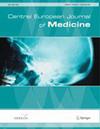Adherence to osteoporosis guideline: survey among Czech general practitioners
引用次数: 1
Abstract
Rationale and objectivesGeneral practitioners (GPs) play an important role in management of patients at risk of osteoporosis (OP). The objectives were to assess (1) knowledge about OP and use of OP clinical guideline in comparison with other information sources and (2) association between the use of individual information sources and knowledge and self-reported quality of care among GPs.MethodsSurvey among random sample of Czech GPs was performed to find out their attitudes and role in OP management. The return rate of the postal questionnaire was 38% (525 respondents). Quality of care was assessed using three indicators: suspicion on OP, referral to the specialist and initial check-up.ResultsRespondents (median age 52 years, 59% women) had a very good knowledge of several risk factors, while others, namely low body mass index, history of hip fracture in mother and smoking were perceived as risk factors by only 40%, 45% and 55% of respondents, respectively. 10% of GPs stated the correct answer regarding daily calcium intake recommended for postmenopausal women. The OP guideline was considered accessible by 83% of respondents and used repeatedly by 54%. Use of the guideline correlated positively with knowledge score (P < 0.001), while use of each individual other source of information did not. Use of the guideline correlated with all three indicators of quality of care. Use of each other information source correlated only with a maximum of two indicators.ConclusionWe identified areas of insufficient knowledge that should be targeted in educational activities for GPs. It is recommended to further motivate GPs to use their clinical guidelines regularly.坚持骨质疏松指南:捷克全科医生的调查
理由和目的全科医生(gp)在骨质疏松症(OP)风险患者的管理中发挥着重要作用。目的是评估(1)与其他信息源相比,OP知识和OP临床指南的使用情况;(2)全科医生使用个人信息源、知识和自我报告的护理质量之间的关系。方法对捷克全科医生进行随机抽样调查,了解其在OP管理中的态度和作用。邮寄问卷的回复率为38%(525人)。使用三个指标评估护理质量:怀疑OP,转介给专家和初步检查。结果受访者(中位年龄52岁,59%为女性)对几个危险因素有很好的了解,而其他因素,即低体重指数、母亲髋部骨折史和吸烟,分别只有40%、45%和55%的受访者认为是危险因素。10%的全科医生给出了建议绝经后妇女每日钙摄入量的正确答案。83%的受访者认为OP指南是可访问的,54%的人反复使用。指南的使用与知识得分呈正相关(P < 0.001),而使用每个单独的其他信息来源则没有。指南的使用与护理质量的所有三个指标相关。相互信息源的使用最多只与两个指标相关。结论我们确定了全科医生教育活动中应针对的知识不足领域。建议进一步激励全科医生定期使用他们的临床指南。
本文章由计算机程序翻译,如有差异,请以英文原文为准。
求助全文
约1分钟内获得全文
求助全文

 求助内容:
求助内容: 应助结果提醒方式:
应助结果提醒方式:


